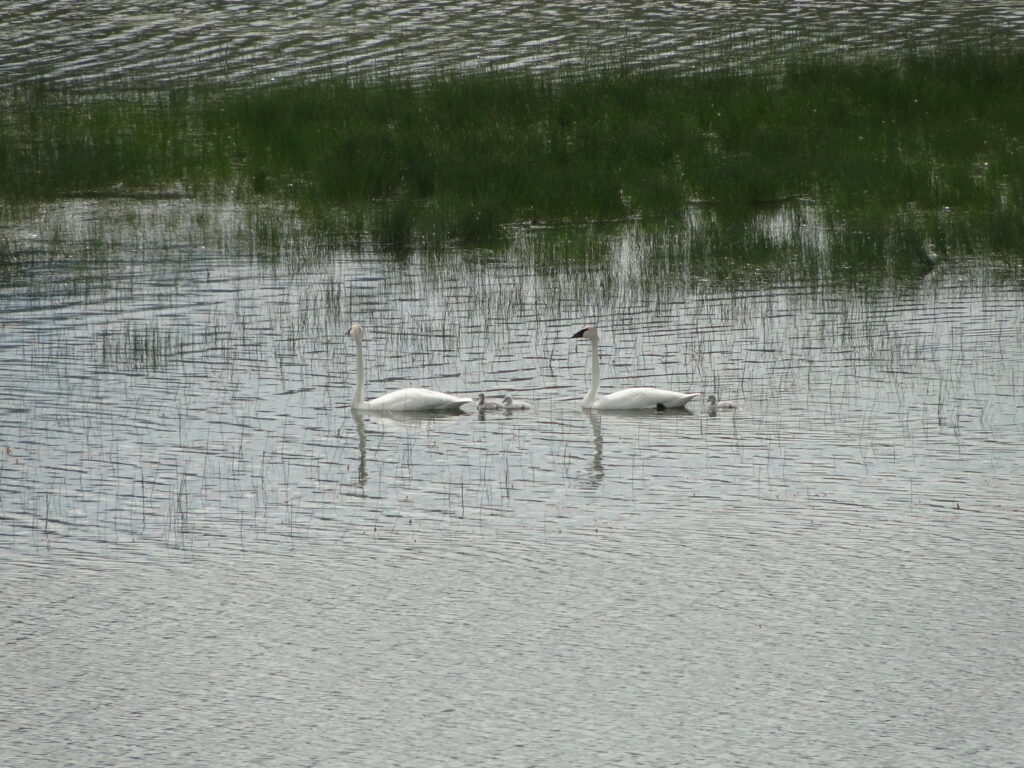Story by Elaine Caton Blackfoot Challenge Education & Swan Program Coordinator
Last year turned out to be a banner year for trumpeter swans in the Blackfoot watershed.
The Blackfoot Challenge and the U.S. Fish and Wildlife Service began working together in 2005 to restore trumpeter swans to the Blackfoot watershed. Thanks to the support and hard work of many partners, landowners, teachers, and schoolkids over the years, we met our project goal in 2022, and the swan population here is now considered officially restored! The goal was to have at least seven successful nests for at least two years in a row. We released young, captive-raised swans almost every year since 2005, in public events that were usually attended by more than 100 students from all our watershed schools.
Trumpeter swans were once widespread over the northern half of the United States, and Meriwether Lewis recorded the presence of a pair of trumpeter swans at the confluence of the Blackfoot and Clearwater rivers in July of 1806. But the swans were hunted almost to extinction in the lower 48 states in the 1800s, when their feathers were highly valued for quill pens and for decoration. Efforts to protect and restore them began in the 1930s, when small groups were discovered in Yellowstone National Park and the Centennial Valley of Montana.
Since then, swans from Canada and Alaska have slowly helped to repopulate parts of their original range where good habitat still exists, along with releases of swans raised in captivity. A pair of trumpeters attempted to nest in the upper Blackfoot watershed, east of Lincoln, in 2003. Because our watershed has abundant healthy wetlands on both public and private lands, we felt confident that with a little help this species could once again thrive in the Blackfoot. The numbers of swans, nests, and baby swans (cygnets) hatched in our watershed has slowly but steadily increased since 2005.
In 2022, Blackfoot swans had their best year yet. The first sightings were reported in March, when swans began returning from their wintering grounds in southwest Montana and Idaho. We estimate that we had at least 20 pairs of swans and about as many younger, unpaired swans in the Blackfoot last year.
The observations that people send us provide some fascinating information about the travels these birds make, and glimpses into their individual lives. Three yearlings that were released in 2021 were sighted on American Falls Reservoir in Idaho last March, when we first found out that they all had survived fall migration and the winter. And they were with another Blackfoot swan, 1V2. 1V2 was released in 2020, and was sighted in Alberta, Canada, in the summer of 2021, just north of Calgary! It is interesting that these Blackfoot swans somehow found each other in the large flocks that winter in southeast Idaho. Does it have anything to do with the matching red bands on their legs? Or is it something more natural that lets them recognize fellow Blackfoot birds?

Blackfoot trumpeter swan family; Photo by Kevin Ertl
While our three young swans from 2021 returned to the Ovando area this spring, 1V2 continues to be a wanderer, and she was sighted in June in the Mission Valley, where the Confederated Salish and Kootenai Tribes have been restoring swans for many decades. Although we generally hope the swans we release will return to the Blackfoot, we also want Blackfoot swans and Mission swans to mix sometimes in order to keep genetic diversity high and prevent inbreeding.
We had 10 pairs of swans nest in the Blackfoot last year, and eight of those nests hatched a total of 30 cygnets. That is the highest number of active nests, the highest number of successful nests, and the most cygnets hatched since our restoration program began. Additionally, the population is expanding geographically – two pairs of swans nested successfully in the neighboring Swan Valley in 2021 and 2022. We know from collars that one swan had been released in the Blackfoot and its mate is from the Mission Valley population.
Because of the success of the program, we don’t plan to release more swans. But we will continue to monitor the population to make sure this positive trend continues, and your observations are a very important part of that. You can use our simple online form to report sightings on the Blackfoot Challenge website at https://blackfootchallenge.org/trumpeter-swans/, by downloading the free Survey123 app (no account necessary) and searching for the Blackfoot Trumpeter Swan Survey, by reporting sightings to elaine@blackfootchallenge.org, or by calling our office at 406-793-3900. You can also view a map on the website that shows all the know swan locations since 2005!
Thanks to the many, many landowners, residents, and visitors who have supported the project over the years and who continue to protect wetland habitat and enjoy these magnificent birds on our landscape.
